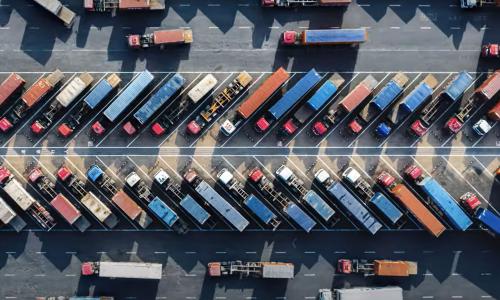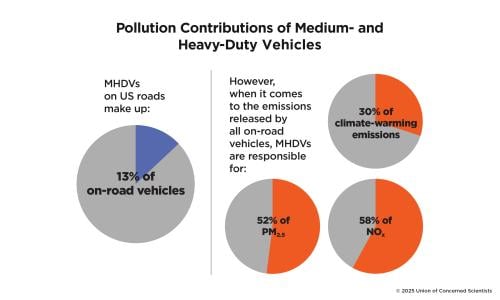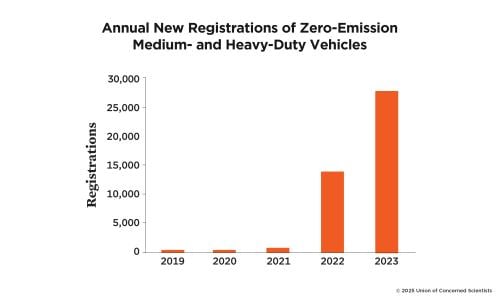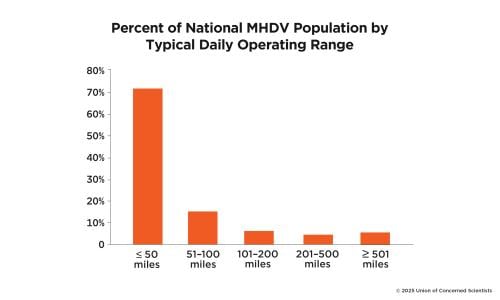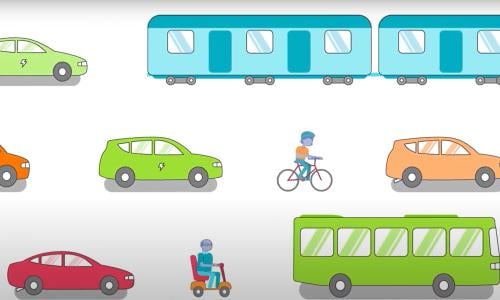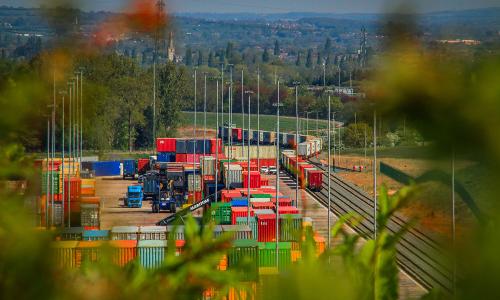Medium and heavy-duty vehicles are an essential part of our economy, moving billions of tons of cargo each year.
But they are also responsible for a massively disproportionate amount of pollution from on-road vehicles. Although MHDVs make up just over 1 in 10 of the vehicles on our roads, they emit over half of the fine particulate matter and nitrogen oxides from on-road vehicles and are also responsible for a disproportionate and increasing amount of climate-warming pollution. This pollution also leads to significant health issues including premature deaths and respiratory illnesses---particularly among populations close to ports, railyards, warehouses, and freight corridors.
Electrifying our on-road freight system is the surest way to reduce truck pollution and improve air quality. The number of zero-emission trucks has grown significantly recently, and key policies are accelerating their adoption. These policies not only reduce pollution but can also lower up-front costs directly and indirectly, enabling fleets to benefit from the operational savings of electric trucks sooner.
Ready for Work 2.0
This is an online version of the executive summary. The full executive summary can be downloaded here
Medium- and heavy-duty vehicles (MHDVs), like the trucks that move containers and the vans and box trucks that deliver packages, are essential to our economy, moving billions of tons of cargo each year. However, they are responsible for a massively disproportionate amount of pollution from on-road vehicles. Although MHDVs make up just over 1 in 10 of the vehicles on our roads, they emit over half of the lung-damaging fine particulate matter and ozone-forming nitrogen oxides from on-road vehicles (see Figure ES-1).
Despite meaningful progress in cleaning up on-road freight, pollution from trucks, particularly those powered by diesel fuel, continues to be a persistent and significant problem for human health and the environment. Historical inequities in access to clean air are still experienced acutely by communities close to freight corridors, ports, and warehouses, leading to increased rates of premature deaths, sickness, and lost school days and workdays. Furthermore, as the economy grows and the population increases, the number of miles traveled by on-road freight vehicles is anticipated to grow, resulting in continued exposure to toxic diesel emissions.
The surest way to reduce pollution from trucks and create more equitable access to clean and healthy air is to electrify our on-road freight system. Thankfully, the number of zero-emission trucks has increased remarkably in the past few years. Also, several key policies have shown promise in accelerating the adoption of clean trucks while reducing costs to fleets.
New data reveal that the MHDV market has shifted into a new phase. A few years ago, electric vans, buses, and trucks were essentially concept vehicles. Today, more than 70 models of zero-emission MHDVs are being put to work by major corporations, small businesses, local governments, and school districts from Washington State to Florida. Zero-emission vehicles are being used to unload cargo from ships, transport food and beverages to regional warehouses, and deliver packages to your front door.
This shift is in part because of rapid technological advances that are making zero-emission trucks a practical and increasingly affordable choice for fleet owners and individuals. The adoption of new technologies often follows an S curve marked by exponential growth. The zero-emission MHDV market appears to be beginning to take off---in just four years, the number of vehicles hitting the road has grown from under 1,000 to over 27,000 (see Figure ES-2). This jump could be the start of a new on-road freight paradigm, one that sharply reduces negative impacts on public health and the climate and delivers significant operational savings to fleets.
We are still quite early, however, in that trajectory. Growth has been dominated by smaller vehicles, such as delivery vans, and more work is needed to accelerate the electrification of larger, more polluting vehicles. It remains a critical time for governments to maintain and expand supportive and innovative policies, for manufacturers to follow through on their commitments to clean trucks, and for businesses and fleets to continue deploying charging infrastructure across the country.
Here, we analyze and review aspects of today's on-road freight system as well as public policies, technologies, and economics to better understand the opportunities for and roadblocks to accelerating the transition to a sustainable on-road freight system.
Transitioning to Zero-Emission Trucks Delivers Benefits for Both Public Health and Fleets
The MHDVs on our roads and highways are responsible for a disproportionate and growing share of the toxic air pollution and climate-warming pollution emitted from the transportation sector. While exposure to pollution from trucks is unhealthy for anyone, certain populations and communities are exposed at greater rates than others. Our review of the science clearly shows that communities close to ports, warehouses, railyards, highways, and other hot spots for truck traffic tend to experience negative health impacts related to truck pollution at rates far greater than communities further from freight corridors.
Transitioning our on-road freight system to zero-emission trucks can lead to meaningful reductions in tailpipe and life-cycle pollution. Even when powered by today's energy grid and generation mix, battery-electric trucks (BETs) produce far less toxic air pollution and climate-warming emissions than those powered by internal combustion engines. As more renewable energy generation comes online, BETs become even cleaner.
In addition to their air quality and climate benefits, BETs have far lower operating costs than vehicles powered by other fuels, delivering significant economic benefits to fleets. The total-cost of ownership of zero-emission trucks can be lower than that of combustion models today, despite higher upfront costs. Research suggests that the up-front prices of zero-emission trucks are expected to decline over time, but the prices of some larger electric truck models have stagnated or increased in the United States even as prices in other markets have declined. Some smaller types of zero-emission on-road freight vehicles, how-ever, have lower off-the-lot costs today than analogous gasoline and diesel models, thanks in part to federal incentives.
Regulations and programs that boost the availability of electric trucks, promote their adoption by fleets, offer purchase and equipment incentives, and encourage a competitive marketplace will help the market to realize up-front cost parity between combustion and zero-emission trucks. As the market for zero-emission trucks matures and manufacturing costs decline, fleets can sooner take advantage of the significant operational savings that clean trucks offer. Maintaining and expanding state and federal policies that further the adoption and domestic manufacturing of zero-emission trucks is key to developing the market.
Zero-Emission Trucks Can Meet the Demands of Most Duty Cycles
Our analysis shows that the daily mileage of most trucks on the road falls well within the range of currently available zero-emission models. Over 85 percent of MHDVs travel fewer than 100 miles each day (see Figure ES-3), meaning that many fleets could reasonably meet their daily duty cycles with zero-emission trucks and refuel overnight at their depots. And across the country, fleets with duty cycles of higher energy demands, such as refuse collection and utility maintenance, are taking advantage of zero-emission options.
In addition to their numbers, the capability of available zero-emission tractor truck models is growing, with most battery-electric models today capable of traveling more than 200 miles fully loaded on a single charge. Particularly for tractor-trailer fleets that return daily to a set depot, this advancement presents a strong case for near-term electrification given that a 200-mile range covers the daily mileage of over half the tractor-trailer trucks operating on our roads today. Longer-range zero-emission tractor-trailer trucks capable of traveling 500 miles when fully fueled are also hitting the roads with notable success in pilot projects.
We find that developing reliable charging infrastructure along freight corridors and near freight hubs such as ports, warehouse districts, and intermodal facilities is critical for overcoming both real and perceived obstacles to accelerating the deployment of regional- and long-haul electric tractor trucks. Both public and private investments in charging stations have grown tremendously in recent years, with charging stations coming online and being planned across the country. Industry standards for high-powered "megawatt" charging for battery-electric heavy-duty vehicles have recently been released, which will further influence the successful deployment of fast-charging stations to support larger zero-emission trucks.
Fleets Are Adopting Zero-Emission Trucks at Record Levels
The momentum behind zero-emission trucks has swelled over the past several years, with registrations of electric trucks reaching record levels each year. In 2019, there were fewer than 1,000 new zero-emission trucks, buses, and vans registered in the United States. In 2023, there were more than 27,000. Both large and small businesses across the country are adopting zero-emission trucks into their fleets and beginning to realize the significant operational savings electric trucks deliver.
While the growth in zero-emission truck deployments has been impressive, the majority thus far have been smaller vehicles, like delivery vans. Given that most pollution from on-road freight comes from larger vehicles, like tractor trucks, more work is needed to accelerate the electrification of these vehicles.
Maintaining and Expanding Clean Truck Policies and Programs Is Paramount to Ongoing Progress
Despite the market showing meaningful movement toward zero-emission trucks, policies, programs, and regulations are necessary to seize this recent momentum and accelerate a feasible, equitable, and lasting transition to cleaner on-road freight. If we are to begin to address the existential threat of climate change and rectify the historical inequities in access to clean air, we must ensure that the pace of progress matches the urgency of the need.
State policies that require manufacturers to offer increasing numbers and types of zero-emission models and recent federal truck emissions standards have laid clear and flexible paths for industry while creating billions of dollars in public health benefits. Policies that promote truck electrification present an all-too-rare win-win for public health, the environment, and industry. By strengthening and expanding the market for zero-emission trucks, regulatory strategies help to increase competition and advance emerging technologies, which drives down the up-front costs of new zero-emission vehicle models and allows businesses to take advantage of operational savings even sooner.
This is an online version of the executive summary. The full executive summary can be downloaded here
Downloads
Citation
Wilson, Sam. 2025. Ready for Work 2.0: On the Road to Clean Trucks. Cambridge, MA: Union of Concerned Scientists. https://doi.org/10.47923/2025.15779
